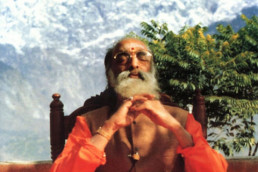The Sankalpa for Sidhbari
Sidhbari means the abode of Siddha Purushas (the spiritually enlightened). Sidhbari is a place of sacred significance, holding a special place in the history of Chinmaya Mission. Located in India’s Himachal Pradesh, Kangra District, about 7 kilometers away from Dharamsala, it is home to Chinmaya Tapovan and is the site of Sandeepany HIM (Sandeepany Himalayas). Named with great reverence by Pujya Gurudev in honor of Parama Guru Swami Tapovan Maharaj, the ashram in Sidhbari is a place where penance and devotion shine.
The story of how Sidhbari, Pujya Gurudev, and Hanumanji came together is a story of persistence, penance, harmony, and devotion. When He recognized the spiritual aura of Sidhbari and had the divine sankalpa to build an ashram there, the obstacles were many. Even the locals of Sidhbari, in order to protect nature, resisted new development and newcomers at the time. With the help of Col. L.S. Pathania, the land was procured on a 99-year lease, which only recently, thanks to the efforts of Svargiya Swami Subodhananda (1958-2020), has been registered as a Chinmaya Mission property.
With the site purchased, the next challenge was the forceful gales of winds and heavy rains. The land was barren as strong winds uprooted vegetation, and heavy rains caused boulders to come hurtling down from the mountains. Slates of rock and piles of sand brought in for construction would be thrown around and blown away overnight. No high-rise building could even be attempted in the windy, high altitude among the mountains and open land. As Pujya Gurudev observed this hurdle, he declared and invoked, “Let Vayuputra Hanuman be here.”
Shri Hanuman - Victory and Worship

The son of Wind-God would be gigantic. As the Tejasvi Amshavatara, the son of Lord Shiva born in Mother Anjana’s womb through Vayu as His instrument, the Vayuputra had to be there to serve and support future growth. Though He held His mace (gadha) with powerful grace, He would kneel in devotion, ready to serve His Lord Rama who would arrive in the ashram a few years later! As Hanumanji took form in Sidhbari, the winds grew calmer, and the land rejoiced with lush fertile growth.
Here is a transcript of the interview with Shri Kashinath Shilpi and his crew who came to sculpt the splendid Shri Hanumanji. After the Vayuputra idol was completed and stood victorious in Sidhbari, divinity manifested all around in the structures built. The massive Shivalingam that crowned Pujya Gurudev’s kutiya signaled auspiciousness all around, and the idol of Nandi in front of the kutiya was the ready vehicle for service.
It was important to offer gratitude and worship to the supreme sevak, Sri Pavanaputra Hanuman. So, in 1982, Pujya Gurudev inaugurated the tradition of the once-in-five years Mastakabhishekam in Sidhbari. Pujya Gurudev wanted the whole of Sidhbari to rejoice and pray as the lustrous 16-ft Hanumanji atop the 6-ft pedestal would be consecrated with Panchamruta Abhishekam from crown to feet. The army personnel who lived in the Yol Cantonment nearby offered their service to construct a massive ramp to lead up to the top of the idol. Here is the timeline with key details of the Mastakabhishekams that have continued since 1982.
The 9th Mastakabhishekam ceremony at Sidhbari, is being held on October 10th, 2022, and the traditional festivities that have become a time of joyful worship at Chinmaya Tapovan, Sidhbari, are already under way.
The son and sage of Sidhbari

The spiritual aura of Sidhbari and the love of the simple-hearted natives that embraced Pujya Gurudev made Him the celebrated son of Sidhbari. After being spiritually born as Swami Chinmayananda in the Himalayas, Pujya Gurudev carried the essence of Hinduism and Vedanta around the world, making Sidhbari a memorable part of His mission. Even as He belonged everywhere, there was a deep connection with the pristine and spiritual environment at Sidhbari. Pujya Gurudev could cajole and command the elemental forces there. Many have witnessed how Pujya Gurudev would signal threatening rain clouds to retreat until pujas under the open skies were completed. A lit lamp would stay aflame and not be extinguished by the winds in Sidhbari, a glowing evidence of His harmonious relationship with Mother Nature! When Pujya Gurudev stood with His hands folded across His chest against the backdrop of the picturesque Dhauladhar mountains, the intimate connection of Him with the divine land was strikingly evident. It was that love for and from Himalayas that finally cradled Him in His Samadhi Sthal in 1993.
Truly, the sacred space in Sidhbari holds many blessings that uplift and transport seekers to a soul-stirring, quiet fullness. In this digital pilgrimage to that hallowed Chinmaya Tapovan, we pause to visit Pujya Gurudev’s Kutiya and worship the Guru who brought us those great blessings which we continue to discover.
Related Topics
Related Topics
Sidhbari Intro
In this module, we attempt with a prayer to highlight the beautiful landmarks and special events at Sidhbari that enrich Chinmaya Mission worldwide.
Hanuman Mastakabhishekam
Mastaka means the head; the ritual of Mastakabhishekam is a consecration ceremony where an idol is bathed from head to feet with mainly water and…
Sidhbari Kutiya
A focal point of Sidhbari, Pujya Gurudev’s Kutiya holds deep meaning for devotees and spiritual seekers. In this section, we present important…


